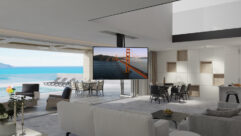
Installation Profile: Carmike Cinemas
Jul 1, 2005 12:00 PM,
By Daniel Keller
Digital signage goes to the movies.
Sidebar
A Moving Picture is Worth a Thousand Words
As any Madison Avenue ad exec will tell you, in today’s media-manic world the number one endangered species is the customer’s attention span. As the MTV generation comes of age, the sheer volume of information vying for our eyeballs is nearly equaled by the number of directions from which it’s bombarding us. As data continues to come at us faster, and from an ever-increasing number of sources, our ability to filter out all but the most immediate and essential information has had to evolve, if only to protect us from sensory overload.
With the help of ActiveLight’s ActiveSource division, the Carmike Cinemas theater chain implemented a digital signage network in its more than 300 theaters. Displays over the concession areas provide dynamic pricing and promote sponsored products while smaller kiosks with focused audio show trailers of coming attractions.
In this oversaturated world, where zapping commercials is so ubiquitous that “Tivo” has become a verb, the rules have clearly changed. It’s no longer enough simply to make an impression. Now, more than ever, to expand on an old saying, timing — and focus — is everything. The dominance of major TV networks is a thing of the past, and those companies whose commercials are being zapped are now looking for new avenues to effectively reallocate those advertising dollars. And as the increasing sophistication of networking technologies converges with the advent of better quality, more compact, and more affordable displays, digital signage has emerged as an avenue that can deliver the message with unrivaled timing and focus.
THE CARMIKE EXAMPLE
It’s hardly surprising that the movie business, with its innate understanding of the power of visuals, would be early adopters of digital signage. Carmike Cinemas, a fast-growing theater chain with more than 300 theaters in 36 states, was one of the first theater chains to investigate the technology’s potential.
“The Carmike people originally approached us about plasma displays,” recalls Scott Stanton, digital signage technical services manager at Washington-based ActiveLight, “but their long-range objective wasn’t really defined. They just knew the displays looked great and were certain they’d be useful in some context.”
ActiveLIght, a major distributor of projectors, flat-panel displays, and digital signage components, has recently launched its new ActiveSource division, aimed at helping to guide the selection and implementation of digital signage systems.
“ActiveLight gets calls daily from users, integrators, and suppliers in other market segments, saying they want to implement digital signage,” remarks Jennifer Fisher, ActiveLight’s digital signage coordinator. As Fisher notes, the range of inquiries varies widely. “On one end of the spectrum are users who are clear on exactly what they want, down to individual system components. On the other end are people who … may not even understand the technology and its potential. That’s why we created the ActiveSource division — to help bridge the gap and address the needs of users across that entire spectrum.”
In the case of Carmike, Stanton says, “When Jennifer started talking to them about their objectives, it became clear there was a wealth of possibilities they hadn’t considered. Ultimately, she was able to help them create a networked system that was far more impactful to people coming into their theaters than anything they had originally envisioned.”
In addition to providing dynamic pricing, displays over the concession areas promote sponsored products, driving sales of featured items. Elsewhere in the lobbies, smaller kiosks with focused audio are programmed to run trailers of coming attractions. Playlists for these displays are created according to each venue’s upcoming schedules.
Fisher adds, “We asked how many locations they were going to have, and when they said ‘over 300,’ we brought up the issue of how they planned to manage them. Their concession people wouldn’t be technically qualified to maintain the displays, and besides, those people already have a job. Putting one or more dedicated people on staff would be costly and inefficient. The logical alternative was to put together a network.”
ActiveLight and Scala worked with Carmike’s David Pflegl to plan a networked system that would be based at the company’s headquarters in Columbus, Ga. Content generated at the Columbus location can be networked to any or all of Carmike’s theaters using Scala’s InfoChannel 3 software, with control over each venue’s specific programming. Each venue’s displays can be monitored and maintained remotely via the dedicated Ethernet server.
THE PRICE OF ADMISSION
One issue that always rears its head is the cost of investing in a technology. Plasma displays have historically been a high-end commodity, but as manufacturing techniques advance, their cost is beginning to decline. And, as Stanton points out, the increased revenues more than justify the initial investment. “From the perspective of ‘How much is it going to cost?’ we can turn that around and ask ‘How much can you make?’ The ability to monitor sales [and] match sales to display content, and the immediacy of that feedback, is invaluable to most businesses.” And, in many cases, the displays themselves draw the customer into the venue.
Recouping the actual investment is also a much faster process than most users expect. It’s not unusual for vendors to rent out advertising space on a display, as has occurred in the Carmike venues. “One bar owner actually recouped his investment in a day,” says Stanton. “The day the display was installed, his beer distributor came in and offered to pay for monthly ad space. That first payment covered the cost of the display.”
“We were pleasantly surprised at the cost of the system,” Pflegl confirms. “We expected it to be far more expensive than older static display technology, but the difference was very minimal.”

Front-end components in the digital signage network include three HP DC7100 computers equipped with ATI Radeon X300 video cards and Scala InfoChannel 3 players. Using a PS/2 KVM switcher, the three PCs share a single NEC 17in. Accusync LCD72V monitor and Adesso ACK-730 industrial keyboard.
SUM OF THE PARTS
Although there are countless permutations, the typical network has three basic elements to it. The back end typically is based at the company’s headquarters and consists of a centralized information content management system, typically a data server of some type, into which content provided by an ad agency or other creative source is compressed and uploaded.
The actual network backbone, which connects the central server with each location, can use various configurations, including satellite links or wired or wireless terrestrial. In most cases, it’s a combination of all three. As Fisher observes, the nature of that backbone largely depends on how much content the network needs to carry. “It all comes down to bits. How many cars do you want to get on that freeway?” A data-only feed will require less bandwidth than multiple video streams. With a number of fairly remote locations in smaller cities, the Carmike network relies largely on satellite broadband.
The final component is the front end, where a player receives the data and renders it to video — and, in some cases, audio — for the onsite displays. Data formats can vary widely, including HTML, Flash, MPEG video, audio, or simply raw data, such as a stock ticker. The player stores the display data locally, cueing it to a programmed playlist.
“Depending on the scale of the customer’s network, a wide range of infrastructures is available,” Fisher explains. “One of the most complex elements is to select the right software and hardware to match the content and the application, as well as the potential for expansion. These are the aspects we want the customer to consider before they even start buying displays.”
The Carmike 14 Theater in Tyler, Texas, is typical of the company’s implementation strategy. The lobby is outfitted with 17 Samsung SyncMaster 403T 40in. LCD monitors, each connected to the network via a dedicated Minicom 0VS23004 Cat-5 display remote.
A single Middle Atlantic ERK-4025 40-space rack hosts the rest of the front-end components, including three HP DC7100 computers outfitted with ATI Radeon X300 video cards and Scala InfoChannel 3 players. A PS/2 KVM switcher allows the three PCs to share a single NEC 17in. Accusync LCD72V monitor and Adesso ACK-730 industrial keyboard. Minicom 0VS22011 Cat-5 display broadcast units and a Minicom line splitter connect to the outside world, and a single QSC DCA1222 amplifier provides audio for the trailer displays and interactive kiosks.
SEEN BUT NOT HEARD
The merits of adding audio to the display are also something of a variable. In some cases, such as Carmike’s displays used for trailers of coming attractions, audio is a must-have. Stanton is quick to point out, however, that its implementation is a delicate issue and needs to be focused to a very tight area. “In many installations, audio actually ends up detracting from the effectiveness of the display,” he notes. “Typically, if you put a repeating audio loop into a confined area like a concession counter, the people working in that area will become increasingly annoyed with it and will probably find a way to disable it.”
One logical assumption is the eventual fusion of digital signage technology with actual broadcasting networks. As Stanton observes, although some broadcasters are beginning to look into the potential, a number of obstacles remain with regard to licensing issues. “Networks would have to provide a clean feed to avoid conflicts with their own advertisers. For example, a bar broadcasting a sporting event might have a beer company paying for advertising space on the sign. What happens when a competing beer commercial comes on right next to it?”
Jeff Porter, executive vice president of Scala, offers another example: “Say you’ve got a bank running an MSNBC or Bloomberg feed for their customers. Without a clean, advertiser-free feed, that customer is likely to see an ad for E-loan or Ditech, possibly offering a lower equity rate, while they’re waiting for a teller. Bad idea.”
THE NETWORK ADVANTAGE
Although delivering a focused message is probably the single biggest advantage behind digital signage, it’s hardly the only one. System management in particular is an essential element of any large-scale network, and the ability to monitor the network remotely can represent a tremendous savings in money and manpower.
“If a display goes down, it may take people working at the counter, with their backs to it, quite a while to notice,” Stanton observes. “Different vendors have different thresholds for how much downtime they can tolerate, but in all cases, a dead display is a huge black eye. And they’re unlikely to have a dedicated person on staff to address it. So we tend to specify local AV companies and components that can be replaced or repaired quickly.”
PLANNING AHEAD
As with any major network, proper planning is critical. Often overlooked is the need to interface with a venue’s existing technology base. As Stanton observes, “Particularly in very vertically integrated companies, a marketing or advertising rep may have very little contact with their company’s IT department. So we bring that up — where does the IT department fit in, and how can we give them something they can work with? In some cases, we may integrate with their existing network. Even if we overlay completely discrete networks there could be conflicts, for example, with wireless units.”
“Building the network isn’t just about what they’re doing now, it’s about the future,” Fisher offers. “We help them plan it out, so that as they expand and add locations they’re ready and can manage it all from a single location. It’s a tremendous savings in maintenance costs, as well as monitoring and security issues.”
As Stanton puts it, “Good planning will help that customer to grow, and they will embrace the technology for how it can meet their needs. Poor planning will inevitably yield a negative result, turning them off to the technology.”
“What we’re doing through ActiveSource is trying to make it easy for people to get into the technology,” Fisher concludes. “There are so many choices for content software, displays, players, and hardware that the new user is sometimes overwhelmed. They know it’s a great marketing tool, but they don’t want to deal with learning all the technical aspects of it — they’ve got other jobs. Based on what we find out about their needs and their level of technical expertise, we can jump in at whatever point they need us, make recommendations, and help walk them through the process.”
“At its most basic, digital signage is about touching the customer at every step along the way with an engaging message that informs, entertains, and has a positive impact on sales,” explains Porter. Scala provides software for dynamic signage networks, with offices in the United States, Europe, and Asia. As Porter observes, done correctly, digital signage can deliver a focused message to a qualified audience at the optimal moment.
A Moving Picture is Worth a Thousand Words
Dynamic Digital Signage Comes of Age
Although nearly everyone has been exposed to digital signage in some form, few people really understand the potential of the technology, explains Scott Stanton, digital signage technical services manager at ActiveLight.
The company works with a range of partners, allowing it to function as a one-stop shop and prescribe the optimal solution for each customer through its new ActiveSource division. “We’re brand-agnostic,” Fisher continues, “because people’s needs are different. One customer may need a single display location, while another may need a thousand. So we don’t try to provide a specific product; rather, we try to configure a solution.”
“People need a place to go where they can find answers and find out about options they may not have considered,” Stanton adds. “We’ve found that, while many people are aware of the technology, they frequently aren’t informed as to all it can do for them.”
More than flashy eye candy, a well-designed signage network represents a whole new avenue for reaching the right customer at the right time and place. “In a sense, we’re talking about something that’s almost the antithesis of broadcasting,” Stanton says. “The old broadcast model involves disseminating the message to as wide an area as possible, playing the odds that you’ll hit a reasonable percentage of qualified customers and that they’ll retain that information until they make a purchase. With digital signage, we’re directing the message to a focused, pre-selected audience, virtually all of whom are already qualified. And we’re getting that message to them immediately, when the product is within 20ft.”
Jeff Porter, executive vice president of Scala, agrees, “The closer you get to the point of purchase, the better your chances of influencing the sale.”
A WORLD OF POSSIBILITIES
Far from being simply a tool to manipulate the unwitting consumer into yet another impulse purchase, networked digital signage can provide both assistance and opportunity. From up-to-the-minute informational displays to interactive kiosks, networked signage is becoming a valuable tool well beyond pure marketing.
“The value of this technology goes far beyond retail,” emphasizes Stanton. “There’s an enormous potential for using digital signage in all manner of public venues. People are using it to entertain; to provide image; [and] to inform, drive, and direct the customer. Those who are most successful with the technology are those who are using it to provide real value. A coffee shop whose signage shows local traffic conditions, for example, can influence a commuter to linger over a cup, or take an alternate route. In the U.K., the major train stations use plasma displays to let passengers know how far out an arriving train is, thereby effectively managing crowding at the platforms.”
In fact, as both Stanton and Porter observe, most of Europe is far ahead of the United States in implementing digital signage. Porter cites U.K. retailer Tesco as a prime example of what can be accomplished. “Tesco are deploying a network of over 12,000 Panasonic flat screens in 300 locations. Using Scala’s software, they create seven or eight zones per store — grocery, health and beauty, delis and, of course, checkout. Each zone has specific, targeted content, updated weekly to match what’s on sale.”
Porter points out that the nearest equivalent in the United States is retail giant Wal-Mart, with nearly 10 times as many outlets. “But there’s really no comparison. Wal-Mart deploys fewer screens per store, and the display content is the same throughout most of the store. Their display technology is rather dated by comparison — 27in. CRT displays — and far less visually compelling.”
Europe also leads the United States in deploying the technology in fast-food retail. McDonald’s and Burger King have begun to do some testing in limited markets in the Northeast, replacing the entire menu board area with four plasma screens. But the screens project largely static images and are used primarily for dynamic control of pricing. They have delivered limited ROI. “Contrast that with Burger King in Germany,” says Porter, “where they replaced a single center panel of their menu boards with 42in. NEC plasma displays, continuously looping featured items to augment the static menu. The result was a significant increase in sales of featured items. As an added plus, the CEO of Burger King GmbH was able to broadcast his personal video message to employees before stores opened. It turned out to be an amazingly powerful tool for a very small investment.”
THE CONTROL FACTOR
As Porter observes, the effectiveness of the message is dependent on a number of factors, including content control and location. He adds that locating signage in a relatively high position is usually most effective. “Content is critical. It must be tailored to the audience, lively, and engaging.”
But more than simply controlling content, networking offers the ability to regionalize and customize that data. “Having control over your network is absolutely vital, and the opportunities it presents are enormous,” Fisher explains. “You can implement a national network, but then you can regionalize it for a given application. The permutations are endless.” One such example is Best Buy. Scala provides weekly updates to the retailer’s in-store videos, helping to build a coordinated, regionalized marketing campaign between print ads, TV, and in-store messaging.
Fisher cites another retail example: “If a national chain runs a special, printing and coordinating distribution of paper signage is typically planned months in advance. If a shipping issue arises and a particular region doesn’t get their allotted merchandise, it can represent a significant loss. With dynamic signage, that region can be updated, and it’s no longer an issue.”
Further potential for customization is even more intriguing, Stanton observes. “In a mall, for instance, you typically have different day parts — moms and kids until early afternoon, teens after school, families after dinner, maybe late-night moviegoers. Displays can be programmed to reflect that changing clientele.”
As Porter adds, this degree of customization is useful in other venues as well. “Consider a stadium or arena that has different sporting events or concerts each night. Do they sell beer at
Disney On Ice?
Not likely. What about Gummi Bears at the hockey game? Nope.” The digital menu board offers a way to centrally manage promoting the concessions in coordination with scheduled events. Sponsorship can be sold per event as well, offering more options for the venue, and qualified patrons for the given event.
Another market with great potential for digital signage is the medical industry, particularly pharmacies and doctors’ waiting rooms. Porter points to the recent marketing campaign for AstraZenica’s Nexium, the “Purple Pill.” The company spent millions on print and TV ads, but the tag line, “Ask your doctor if Nexium is right for you,” still didn’t reveal what the drug was for. “What are the chances someone will remember to ask their doctor the next time they see them? Now, run that same ad in the doctor’s waiting room and compare the results.”










